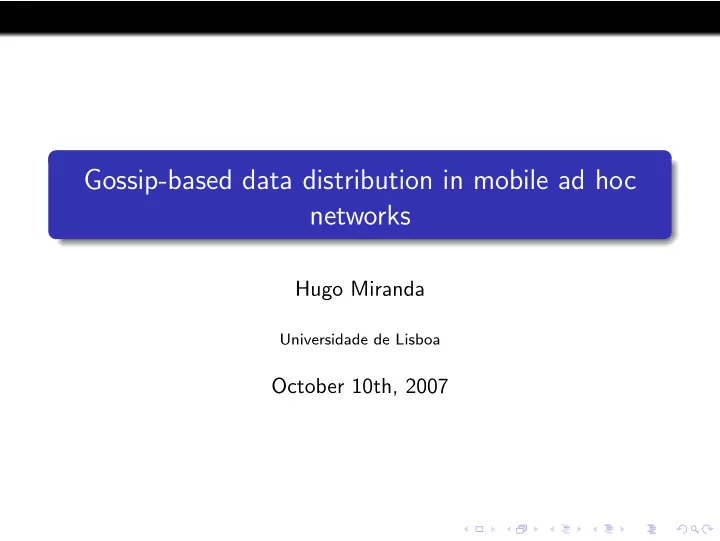

Gossip-based data distribution in mobile ad hoc networks Hugo Miranda Universidade de Lisboa October 10th, 2007
Mobile Ad Hoc Networks Infrastructure-less wireless networks Fully decentralised Composed by devices with limited capabilities Examples: Sensors Personal Digital Assistants (PDAs) Laptops Characterised by an high failure rate Devices fail or are disconnected Intermittent connectivity due to node movement and interference
Applications Cooperative applications: in remote or hostile locations Search-and-rescue operations Military operations Field surveys in ad hoc gatherings of users Meetings Airports Shopping malls
Data storage How to increase data availability in MANETs? posts to a white board SIP/SLP records data collected in field surveys
Requirements Replication Nodes may fail or become disconnected Save resources Moderate number of replicas and messages Geographical distribution of the replicas Tolerates localised interference Reduces latency Saves bandwidth Broad applicability Nodes are not aware of their location Nodes cannot anticipate the data they will require Distribution should be stable even with node movement
Related Work Replica Node Location Access Protocol Refresh/ Movement Awareness Prediction Leveraging Simple Search • Rumour Routing *-SAF • • ◦ Aut. Gossipping • • ◦ Non-Unif *-DAFN • • ◦ *-DCG • • ◦ 7DS • Sailhan et al. • Double rulings • GLS • • ◦ CacheData • DCS • • • CachePath • R-DCS • • • • : feature of the algorithm ◦ : implicitly provided
Components Application Data Management Dissemination Shuffling Retrieval (PADIS) Packet Dissemination (PAMPA) Data Distribution Middleware
Contributions of the thesis A broadcast algorithm for MANETs Requiring a limited number of retransmissions per broadcast A data replication algorithm for small sized data items Providing geographical distribution of the replicas Shuffling algorithms Leverage the replica distribution in the presence of node movement A data gathering algorithm To retrieve an unspecified number of items using a small number of messages
Components: Pampa Application Data Management Dissemination Shuffling Retrieval (PADIS) Packet Dissemination (PAMPA) Data Distribution Middleware
Results of Pampa Power Aware Message Propagation Algorithm Broadcasts with significantly less retransmissions than flooding Improves coverage or reduces retransmissions in comparison with other approaches Self-adaptive to node density Reduces the number of hops
Components: PADIS Application Data Management Dissemination Shuffling Retrieval (PADIS) Packet Dissemination (PAMPA) Data Distribution Middleware
An example of data distribution 250m Arrows indicate devices that ns–2 retransmitted 1500m × 500m 7 copies 100 nodes 26 retransmissions
Components: Queries Application Data Management Dissemination Shuffling Retrieval (PADIS) Packet Dissemination (PAMPA) Data Distribution Middleware
Queries Two attempts Nodes first broadcast the query with a small TTL Set by a configuration constant Adapts to past experiences If no reply is received, broadcast to all nodes Replies are sent point-to-point Use the route constructed during query propagation (like DSR)
Components: Shuffling Application Data Management Dissemination Shuffling Retrieval (PADIS) Packet Dissemination (PAMPA) Data Distribution Middleware
Shuffling algorithms Leverage replica distribution In the presence of node movement To mitigate failures of the initial distribution Triggered by queries Nodes negotiate the content of their storage spaces Four algorithms: State information Preserve Algorithm Piggyback On-demand # replicas Default Swap on Query • • Advertise State • • • Probabilistic •
Benefits of Shuffling 300 280 260 Default Swap On Query 240 Distance (m) Advertise State Probabilistic 220 200 180 160 140 0 500 1000 1500 2000 2500 Time (s)
Application Application Data Management Dissemination Shuffling Retrieval (PADIS) Packet Dissemination (PAMPA) Data Distribution Middleware
SIPCache Distributes SIP’s Address of Records (AORs) on a MANET [Leggio:06] Contributions Dissemination of AORs Improves scalability An efficient algorithm for performing queries with multiple replies SIP dSIP SIPCache − → − → Wired One-hop MANETs Multi-hop MANETs
Conclusions The thesis presents: A broadcast algorithm A data dissemination algorithm Uses the signal strength to geographically distribute the replicas Places a copy of each data item at a maximum (configurable) distance of every node Shuffling algorithms To leverage the distribution when nodes move Piggyback data on query messages The algorithms were experimented in a testbed application
Future Work Experiment other shuffling algorithms Address: Updates of data items Self-configuration of the distance between copies Experiment the algorithms on different applications
Publications H. Miranda, S. Leggio, L. Rodrigues and K. Raatikainen. “A power-aware broadcasting algorithm”. PIMRC’06 . Finland. 2006 H. Miranda, S. Leggio, L. Rodrigues and K. Raatikainen. “An algorithm for distributing and retrieving information in sensor networks”. OPODIS’06 (brief announcement) . France. 2006 H. Miranda, S. Leggio, L. Rodrigues and K. Raatikainen. “An algorithm for dissemination and retrieval of information in wireless ad hoc networks”. Euro-par 2007 . France. H. Miranda, S. Leggio, L. Rodrigues and K. Raatikainen. Chap. “Epidemic Dissemination for Probabilistic Data Storage”. Baldoni et al.(eds.) Global data management . IOS Press. 2006 S. Leggio, H. Miranda, K. Raatikainen and L. Rodrigues. “SIPCache: A distributed SIP location service for mobile ad hoc networks”. MOBIQUITOUS 2006 . USA.
Recommend
More recommend